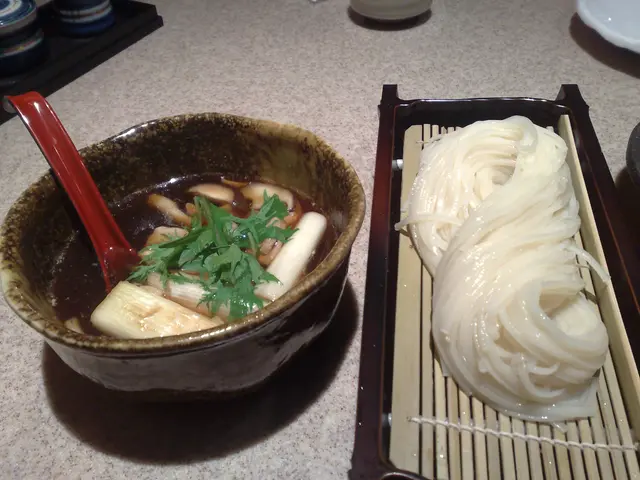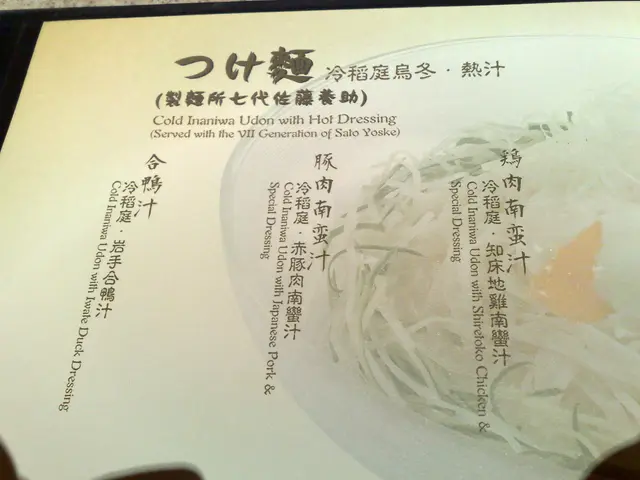更多
2009-10-17
107 瀏覽
If anyone recalls my last two Udon-related reviews, I briefly made an inference that none of the newer Udon shops in Hong Kong are going to be Top Tier Udon Representatives of its kind - despite most owners trying hard to pass them off as "Udon Specialty Shops!". Let's elucidate the line of thought which previously crossed my mind first, before arriving at your own conclusion! As we know, there do exist so many 和式 Japanese noodle shops in Japan already, these comprising of Soba, Udon and Kishi
As we know, there do exist so many 和式 Japanese noodle shops in Japan already, these comprising of Soba, Udon and Kishimen houses, etc on top of Ramen shops. In total, their numbers run into the Tens of Thousands and have infiltrated every corner and train stations. The logic runs likes this - just because there are 40,000 or so dedicated Sushi Specialty Shops and just as many Japanese Noodles Shops, does that automatically mean they're ALL great Sushi or Noodles restaurants? Obviously not. So in terms of 麺屋's, how can customers go about sorting out the ordinary everyday Soba or Udon noodles from the real Jewel of the Crown? The 1st obviously clue is easy, a tag which roughly translates as a '超新鮮, 本地手打' part of the equation, a guarantee that the noodles you will devour are Artisanally prepared daily and served fresh, rather than previously dried or stored in the fridge/pre-frozen during transporation. When it comes to 稻庭烏冬 however, it becomes even more complicated, as despite being Hand-Made rather than Machine-Mass-produced, Inaniwa Noodles are traditionally prepared DRIED '乾' rather than fresh, for purposes of lasting over the cold Winter months!
On the above '新鮮, 本地手打' prerequisite alone, most of the so-called, Local Specialty Udon shops already fail the basic level of filtering out the wheat from the chaff!: 富久保手打烏冬 passes. 自家烏冬 is machine-made but at least made fresh locally. 野姜 or some other shops have 手打烏冬 but they're Japan imported. Here at 稻庭, it passes because Inaniwa noodle are meant to be imported 'Dried'.
Which comes to the next point. At the fresh, Artisanal Hand-Prepared Noodle shops, the general best way to present the Soba or Udon noodles to the customer is to prepare the noodles in a 'Cold state' rather than having the batch of noodles sitting in a Hot Soup or in a Nabe Hotpot (available here) during which the residual boiling and soup's high heat make them lose its Al Dente consistency during the meal and 2ndly, drown away the delicate noodle's wheat taste. Its similar in concept to 中國's撈麵, and is especially the case with Thinner noodle strands such as the Inaniwa noodles and Kishimen noodles - afterall, its ABOUT RESPECTING THE NOODLE. That is how stubborn the Top Japanese noodle makers and customers mutually must treat the Artisanal products and this strict adherence is what makes them all the more delectable! I'm sure we've also heard of stories of how noodle makers insist on using Feet Pressure (足打ち) to finish off the dough and the 'natural sensitivity and intuition' required by the chefs to adjust the formulas according to the Temperature, Proportions and Types of Salt, Water and Wheat Flour to ensure a consistent product! And this leads to my 3rd and most pertinent point: How many ways can we eat the noodles in its Cold, most preferred form? ^_^'
In Summery months, we can eat the artisinal noodles as Zaru (ざる) or Steam Basket (せいろ) style and dip it into cold 'tsuyu based' broths, or have them served in a Cold Soup (冷やかけ) style. Other times you may keep the noodles cold but eat it with various additional cold or warm toppings known as an Bukkake (ぶっ掛け) style. So far, most of these mentioned eating styles are already covered in Hong Kong udon shops.
But what will happen during the colder months, when the stubborn noodle-makers and customers still NEED to respect these Hand-Made Noodles and eat them in their best 'cold' state, yet at the same time satisfy our own desires of wanting to keep warm during winter?
****************
烏冬 (冷) + 雞肉南蠻汁 (熱) -
Surprisingly and as far as I know, all of the other so-called Udon Specialty Shops in Hong Kong do not offer a つけうどん (Tsuke Udon) on their menus - even though this is almost without-fail available at top artisanal udon, soba or kishimen shops in Japan! If you don't believe me - just go check out the other shops the next time you dine out. Although so far a few people in their reviews here have taken for granted and automatically labelled this as yet another 冷烏冬 dish - in reality, its presence on a 'noodle shop's menu' can be highly symbolic of how serious of what the shop is trying to achieve.... at least that's what flashed across my mind when I saw and ordered this from the menu.
When the 雞肉南蠻汁 arrived together with the COLD Inaniwa Noodles (remember: in the wrong せいろ tray ), my anticipation was running abnormally high as this eating method of Dipping Cold Noodles into a Hot Soup is the epitome of eating artisanal noodles in months other than Summer. YET - the 'broth' that I received that night was barely luke-warm rather than a hot soup, my estimate is that it reachd at most 45C!
The Chicken Meat and Shiitake mushroom pieces were quite tasty to be fair, but from my point of view this was already a mistake no.1 by the shop and again, NOT RESPECTING THE NOODLES AND THE CUSTOMER. The cold noodles however just like my last dish were boiled then ice-bathed to perfection, with a strong wheat taste and gliding texture. Amazing!
So how does the shop and the customer usually finish off a つけうどん (Tsuke Udon) dish, may we ask? Well, usually the Japanese noodle makers are SO THOUGHTFUL OF MAKING THE WHOLE TRIP A TRANSCENDENTAL EXPERIENCE, they always make the Original Dipping Broth to be more stronger & salty so that when you dip the cold noodles in it, it shall carry the perfect brothy taste to accompany well with the plain udons! The 2nd part of the equation however is yet another important step as part the the Transcendental Experience - you see, this strong broth is also very delectable, but due to its 濃い character, the PROPER NOODLE SHOPS in Japan will either give you 蕎麦水 (for fresh made Sobas) or 溫水 (in Kichimen with Gingko based soup or Udon shops) automatically to 'dilute' the strongish 'tsuyu' broth first, before the customer will be told by the shop to appreciate the meticulously boiled broth/soup as a Complete Ending to the meal. The same applies to Shabu Shabu's strongish soup, when rice is sometimes added later into the strong soup to absorb and cancel out the concentrated flavours - or sometimes, water added to dilute the shabu's broth so that it can be down as normal soup.
Here at 稻庭 - not only was the Base of the Tsuyu broth already pre-made at the far-away Japanese noodle house rather than made in-store @ Elements (same as its imported noodles!), but no one had offered automatically to assist us to dilute the desirable broth into a great soup so we can finish the meal off authentically in the Japanese way, encouraging us to experience a high apprecation from the Start to the Finish. (I had to ask for some hot water myself and the staff members were entirely clueless and utterly shocked when I pourted this into my own Tsuyu Broth, inorder to dilute it into a drinkable soup.)
**********************************
ALL IN ALL - Although I actually quite enjoyed this meal on the whole and have already concluded that if there is a HK Udon shop which clearly stands above the competition, then this would be it, the overall mishaps here and there that ranged from - wrong serving container which doesn't reflect its 蒸籠 namesake, or the lukewarm Noodles Broth which should have been way hotter if not steaming hot, to the lack of understanding of how a Tsuke Udon should be eaten traditionally, also the careless mis-spellings on the last page of the Menu I was given - I could only arrive at an unfortunate conclusion: This is a Specialty Udon House operated by a HK Group which is exploiting the goodwill of the original 佐藤養助 noodles and broth, without putting Heart and Soul into the food and aiming at doing a 100% job, so as to ensure that each and every customer walking out of the shop afterwards would be 'wowed' by their Top Udon experience.
In a way, this reflects how Hong Kong people and businesses tend to work - its mostly leveraging off established brandnames and only cares about giving you barely 7-8/10 of the full-works and experience, as long as they could charge you the full premium price. It could easily have been a 10/10 experience with just a few adjustments and twitches, but they will never give it to you. As a thought, in the really great artisanal Japanese noodle houses that I was lucky enough to have visited a few years ago, this would never have been a problem, because from the Japanese owners point of view - their priority is always to satisfy the customer first using their own inhouse expectations, therefore the money would come rolling in. In Hong Kong however, its always just the other way around.
FOOD: MID- HIGH '4'
BUT COULD HAVE BEEN EASILY A MID-HIGH '5', IF THEY EVEN PAID A TAD MORE ATTENTION AND DECIDED TO PUT HEART INTO THE FOOD AND RESPECT THE CUSTOMERS AND THEIR 'NOODLES' AS A PRIORITY!!


張貼
 影片
影片
